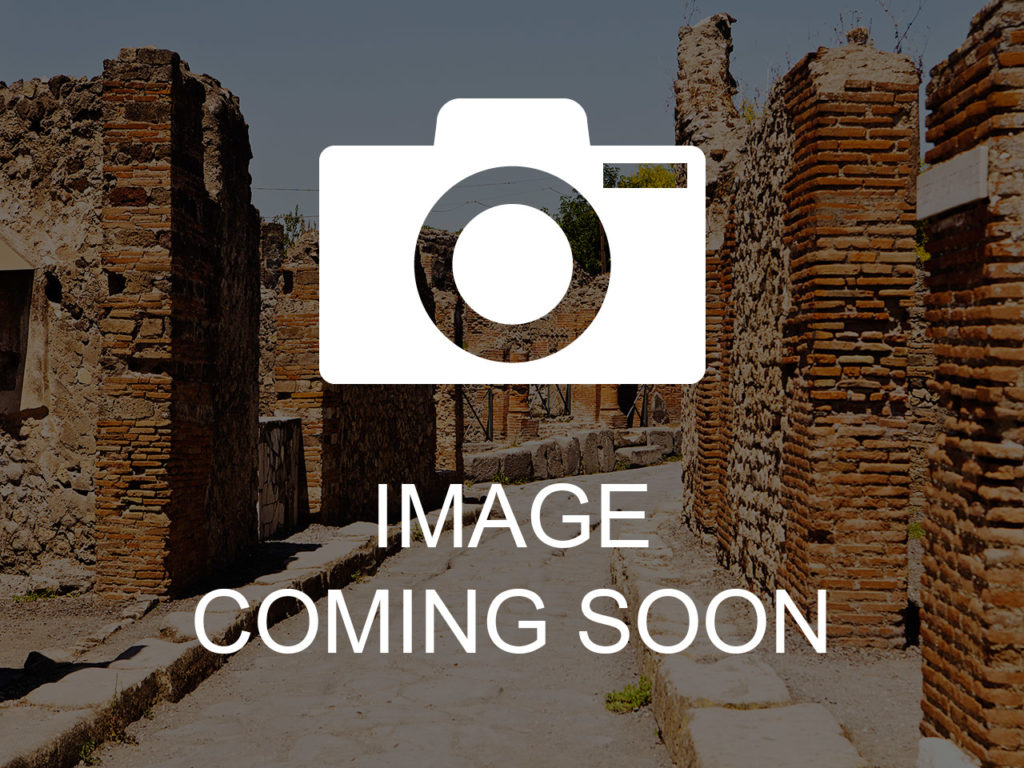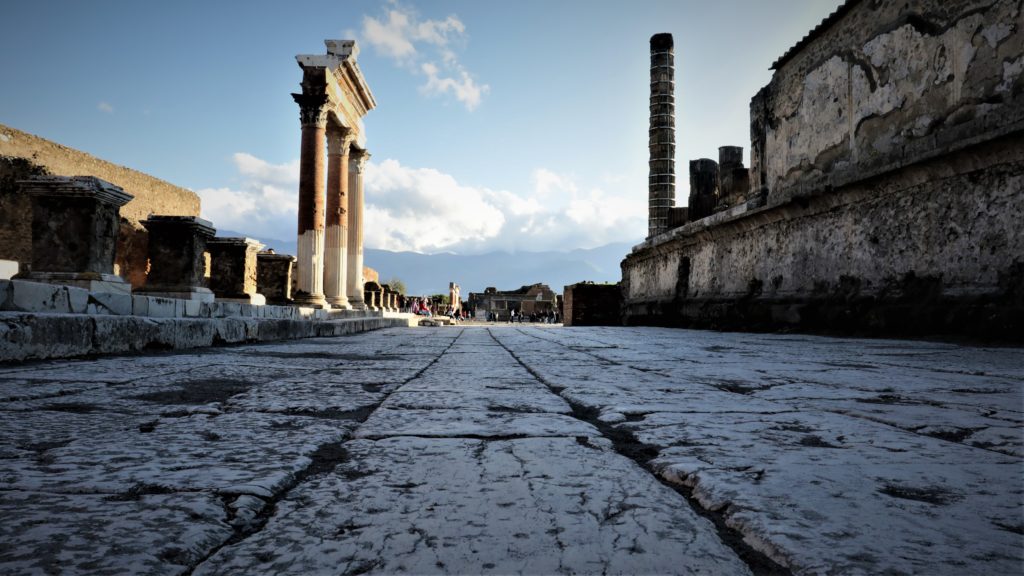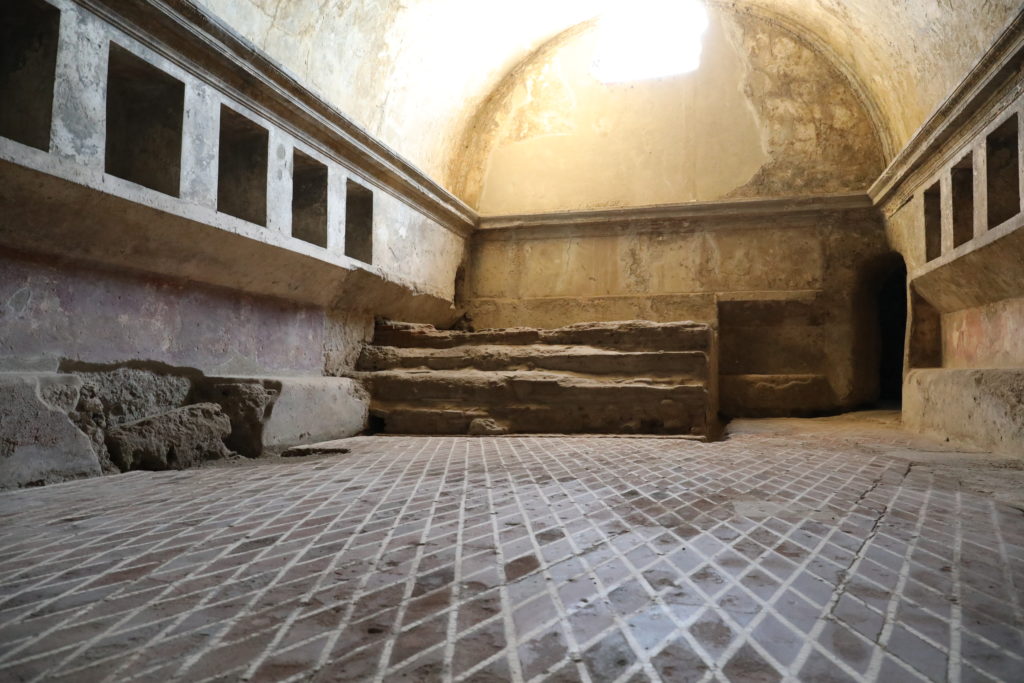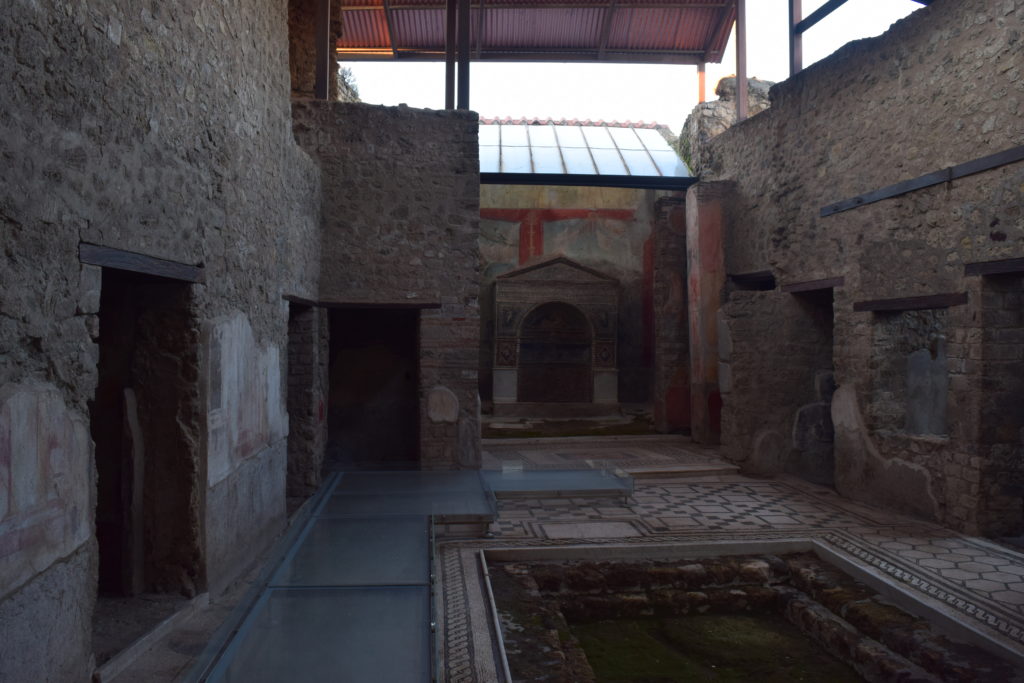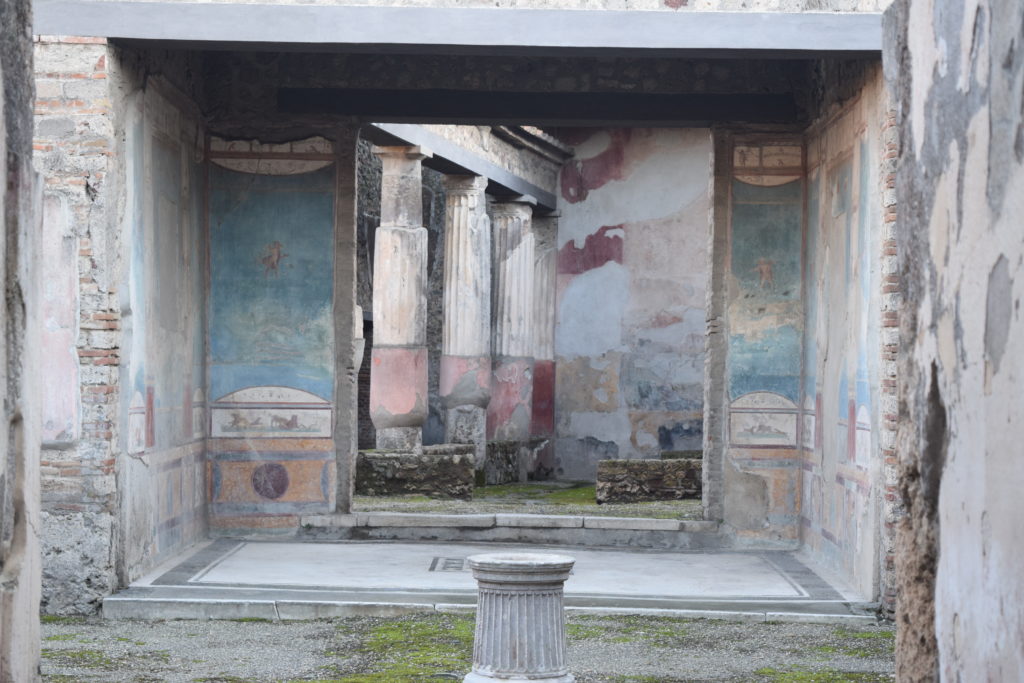Map
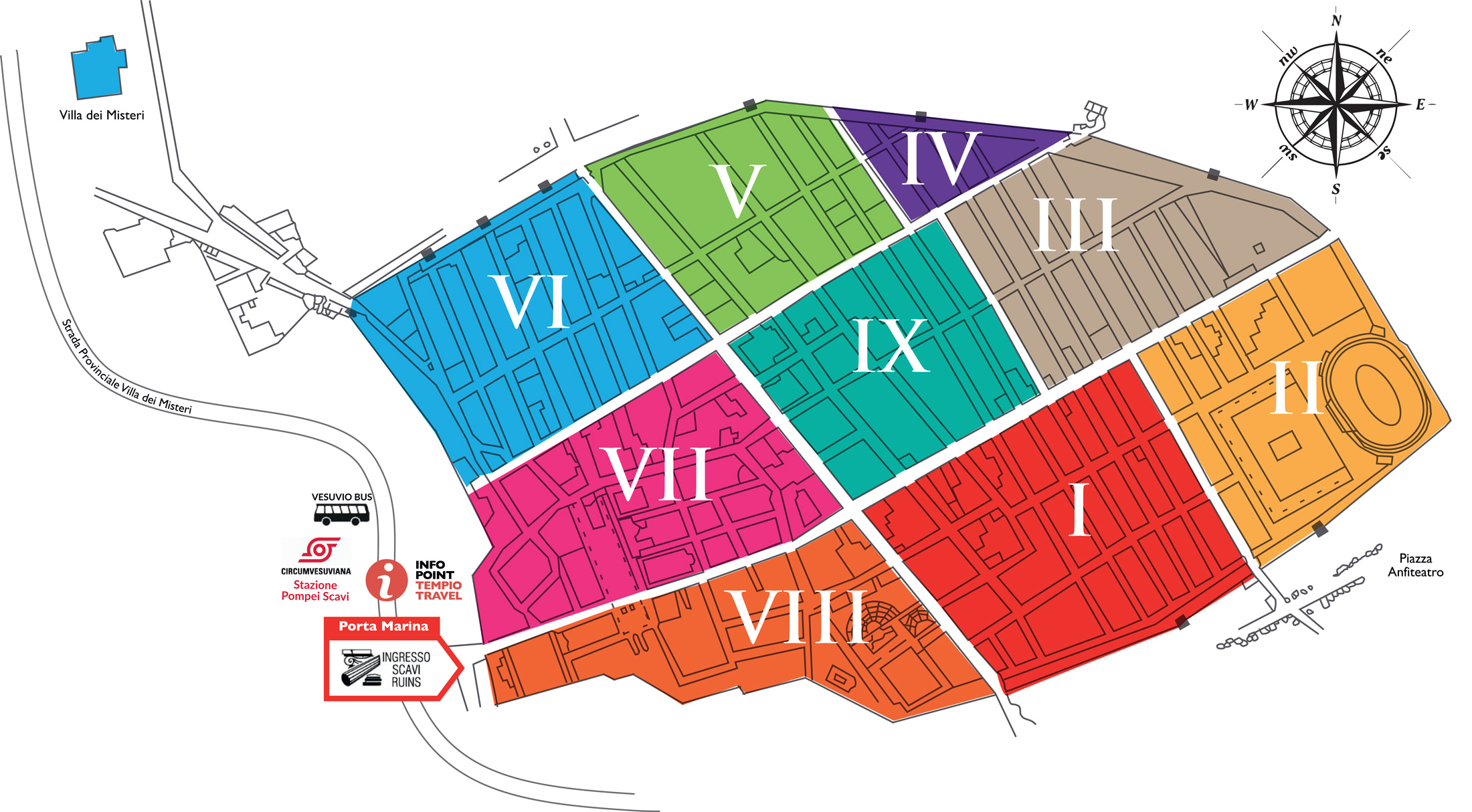
REGIO VII
REGIO I
REGIO II
REGIO III
REGIO IV
REGIO V
REGIO VI
REGIO VIII
REGIO IX
REGIO VII
Suburban Baths
The Suburban Baths were built in the middle of the Julio-Claudian period (I century a.D.) and they were the most technically advanced complex of their time. The building was located outside the walls but close to Porta Marina, one of the city’s several gates. The almost daily ritual of going to the baths was one of the most popular pas-times in the classical period. Usually the baths opened about midday and closed at nightfall, though some were open in the morning or evening. The Romans had the habit of alternating between baths of different temperatures. In this building the decorations were particularly sumptuous; the sixteen small erotic scenes inserted into the fresco in the “dressing room” are highly unusual.
Marina Gate and city walls
The city gates were probably renovated when the curtain was doubled, with arches of Nocera tuff and the typical decoration of divinities in rilief. They must have been partially rebuilt in great haste on the eve of the Social War.Porta Marina is a deep passage covered by a barrel vault that leads up the plateau. A pedestrian corridor, a guard post and a passageway wide enough to allow the passage of horses and pack animals, the whole structural conception of this gate makes it a case unto itself.
The city walls are over 3200 m long: it consists of a double wall with a walkway, protected inside by an embankment. Twelve towers guaranteed defence of the city. After Pompei became a roman colony, a part of the city walls were destroyed to build new houses.
House of the sailor
In allusion to the marine theme of the mosaic pavement of its fauces (latin word to say doorway ) the house became known as the “ Casa del marinaio”(house of the sailor). It was handsomely decorated. The house had been composed of discrete sections on two levels. On the lower story were twenty-seven subterranean rooms, with a bakery to feed workers. A part of the house, because of its large size and secure underground rooms, was long used as magazzini for storage of anphorae found all over the site. Then during the summer of 1943 it was hit by two bombs dropped in an Allied air strike in the area.
House of Triptolemus
The House of Triptolemus was named after a fresco depicting Triptolemus was destroyed by a Allied bombing in 1943. It was a lavish domus with two atriums and two peristyles. The structural modifications and the renovation of the decorative furnishings document the wealth and importance of its owner’s role.
The famous fresco depicting Triptolemus was part of the triclinium’s decoration (triclinium was a dining room). The hero, chosen by Demeter to teach the agricultural arts to humankind, is depicted as receiving a basket of ears of wheat.
In the triclinium two large pieces of the vault decorated with mosaic from the Suburban Baths are exhibited, which were discovered during the 1959 excavation.
House of Romolus e Remus
This house was damaged because of the eruption of 79 a.D. Then, during the war of 1943 it was bombed. The first bomb destroyed many walls and paintings. A second bomb fell on this house causing even more losses.
The painting of The Birth of Rome “Romulus and Remus” was destroyed during this time. The house was named “House of Romulus and Remus” because of this painting.
On the north wall of the peristyle a hunting scene has been restored. During the excavations, five bodies were found here. One person had gold, silver, and bronze coins in his right hand.
Temple of Apollo
Fragments of Attic black and red pottery and inscribed Etruscan bucchero were found in the area of the temple, so we can be sure of the cult of Apollo in Pompeii since the 5th century BC. The ground plan of the temple we see today was restored in the 2nd century BC. Its final restoration was after the earthquake of 62 a.D.
When you enter the temple, you see the continuous colonnade composed of 48 columns, originally there were two storeys. The colonnade was built of tuff, and coated with white stucco. The temple stands on a high podium , in front of which is a flight of stairs. The cult statue was not found and all that remains is the base at the back wall. Near the foot of the stairs is a large travertine altar with the dedicatory inscription with the names of the four officials who erected it when Pompeii was a Sullan colony. Other divinities besides Apollo were honoured in the sanctuary and more statues and altars were placed in the court. A copy of the statue of Apollo has been returned to its original pedestal.
The Forum
The Forum was the centre of Pompeii when it was first founded and even after the city’s enlargement. It was, we can say, the focus of political, economic and religious life. The Forum was quite large, measuring 157 x 38 metres and, together with the surrounding public buildings could contain all the inhabitants of the city. There were different public buildings: temples, markets, government buildings.
The colonnade with Doric columns made from Nocera tuff was built round the Forum in the Samnite period.
The Romans paved the square with travertine and renoveted the colonnade with a second order of Ionic columns above.
Aside from the bases, nothing remains of the many statues that graced the Forum – they were probably never replaced after the earthquake of AD62. Two honorary arches flank the Temple of Jupiter.
Mensa Ponderaria
In the recess of the outside east wall of the temple of Apollo was the mensa ponderaria. It was a limestone table containing bowl-shaped cavities that were the official dry and liquid measures. The original cavities in the table were enlarged and the names of the Samnite measures erased when the Romans conquered the city. The mensa was used to make sure that shopkeepers and traders were effectively selling their customers the correct weight or amount of produce.
Grain stores
The building is currently closed by a gate and is used for storing archaeological findings. Originally it was a market where the people of Pompei could buy cereals, herbs and dried pulses. It opened out onto the Forum and had not been completed at the time of the eruption as the walls show no sign of having ever been plastered.
Temple of Jupiter
The Temple of Jupiter, dedicated to the Capitoline triad of Jupiter, Juno and Minerva, dominates the Forum. It was built in the 2nd century BC.
The temple had six Corinthian columns across the front and five at the sides. The podium, measures 37m x 17m and stands 3m high. Originally there were two triumphal arches at the sides of the temple. The original wall decoration was painted in the first style in faux marble, probably replaced in the Sullan period by frescoes in the second style.
At the rear of the podium was the statues of the Capitoline triad, of which a large head of Jupiter still remains.
9
Triumphal arches
The temple of Jupiter is flanked by two triumphal arches. On the west side of the temple stood the arch of Germanicus. General Germanicus was an adopted son of emperor Tiberius and the father of emperor Caligula. This roman general gained wide popularity by defeating the germanic tribes in the 12 a.D.
On the east side of the temple once stood a triumphal arch which was demolished, so that the third triumphal arch was better visible from the Forum. That arch was dedicated to the emperor Tiberius.
Forum Baths
They were built in the early years of the Roman colony using public funds..
The complex was divided into two separate parts with the central furnace providing hot water and steam to both. The room has a pavement of white mosaic framed with a black band and a vaulted ceiling decorated with stuccoes. Wooden lockers were used instead of niches in walls.
The archaeologists also found a palaestra, it consists of a courtyard with colonnaded porticoes and was used as a general exercise area and as the first stage in the bathing process.
Leaving the palaestra, the bather could enter the tepidarium, an intermediate room, set between the apodyterium and the caldarium or hot room.
Niches along the middle part of the walls are framed with atlantes figures in clay covered with stucco. The next room, the caldarium was heated from the furnaces. The final room involved in the Roman bathing process was the frigidarium .
Temple of Fortuna Augusta
This temple was built on a site previously occupied by shops. It’s a Corinthian tetrastyle prostyle temple on a high podium reached by a single flight of marble steps into which the main altar has been set. An inscription found on the architrave of the temple described the person who paied to build it; he was a famous politician and military officer when Augusto was the emperor. By founding a temple dedicated to public ceremonies on private ground, the benefactor marked not only his devotion to the state but also the strong influence of the locale elite in the construction of public cults. The podium served as the pedestal for the missing statue of Fortuna, the tutelary goddes. Ministers were required to perform sacrifices .
Macellum
The Macellum had three entrances.The main entrance was divided into two passageways by an aedicule set in the centre containing a statue of a member of the Imperial family. Food shopping in Pompei was done in this vast open area. The heart of the complex was a large circular structure, conventionally called a tholos, with fountains. This part of the Macellum was used to clean and prepare the fish to be sold in the market. The remains of several sheep were found in the small room at the north east corner of the court. Such animals would presumably be sold alive so that they could be sacrificed as an offering to the household gods before being used as food. The room to the north of the imperial shrine, has a wide entrance split into three by two columns. The room contains an unusual low altar which was used for the offerings of drink, while the room itself was used for sacrificial banquets. In this room were found two pictures containing cupids.
Temple of Lares Publici
The building has been designated as the sanctuary for the public lares but it may have been dedicated to the deified Augustus. The walls of the sanctuary are built in brickwork, both reticulatum and incertum. What we see today is only rough masonry, but both walls and floors were originally covered with a veneer of fine marble. In the centre of the court are the remains of an altar.
Temple of Genius Augusti (cd. Temple of Vespasiano)
This temple was built after the earthquake of 62 a.D. as a place of worship for the cult of the emperor. A marble altar with bas-relief sculptures can be seen in the centre of the sanctuary. The decoration on the front depicts a sacrificial scene with a bull being led towards the high-priest, portrayed with a veil on his head and pouring out libations on a tripod.
Portico of the Concordia Augusta (Building of Eumachia)
This was a majestic and elegant building with a marble frieze above the portal. Two inscriptions, one on the marble colonnade in the Forum and another by the rear entrance in via dell’Abbondanza – attribute this building to Eumachia, a priestess of Venus and owner of a flourishing business operating in the wool industry. Indeed this was the seat of the corporation of wool and cloth manufacturers. The building was probably built in the Tiberian age. In this building statues of the imperial family’s ancestors were found. Just inside the entrance, on the right side you see a small room used as a urinal. Urine was used to bleach material in the manifacturing process.
Stabian Baths
They are the oldest baths in Pompeii and four different building phases can be identified. The oldest part seems to date from the 4th century BC.
The main entrance to the baths is through a wide doorway on the Via dell’Abbondanza. When you enter you see the palaestra, the gym. The apodyterium, the changing room, has seating round all four sides. Along the side walls is a row of niches for storing the bathers clothing. The vaulted ceiling, in contrast, is decorated with polychrome stuccoes featuring rosettes, cupids,
trophies and bacchic figures. A door on the north side of the apodyterium leads to the next two rooms involved in the bathing process, the tepidarium and caldarium. Both these rooms had their flooring raised on susupensurae and their walls provided with airspaces for the passage of hot air. In the portico on the north side of the palaestra is a statue of a youth with a cloak covering his head. The statue rapresents Hermes, the god of the palaestra.
House of Siricus
The house of P. Vedius Siricus was a large city residence made up of two nuclei with Tuscan atria. Originally there were two separate houses. A seal and other wall graffiti uncovered inside the house, attribute the entire property to the magistrate Siricus. The pavement at the entrance from vicolo Lupanare reads Salve Lucru(m),or “Greetings, profits”. In the centre of the north side of the atrium is a large exedra which is decorated with orange panels with broad dark red frames flanking central panels containing large mythological scenes. The scene on the west side of the exedra shows Neptune and Apollo presiding over the building of Troy. Neptune, armed with his trident, is seated while Apollo, crowned with laurel, is standing. The scene on the north wall depicts a drunken Hercules, crowned with ivy, lying on the ground at the foot of a cypress tree. On the east wall is a picture of Vulcan presenting the arms of Achilles to Thetis.
Between the exedra and the triclinium is a passageway which leads to a small bakery.
Lupanare
The Lupanare, the “wolf house”, was the roman slang for “brothel”. Pompei’s Lupanare was the place where you could have a low-budget affair with its tiny cubicles furnished with built-in masonry couches, a prominent cashier’s desk, and a little one-seat latrine. A series of tiny frescoes above the cubicles presents graphic ideas of what the “she-wolves” and their clients might have gotten up to behind the curtain, they constitued a catalogue of the different sexual positions that might be requested.
The workers were probably slaves: human properties, devoid of rights.The building was under the protection of the god Priapus.
Under the emperor Caligula the roman state imposed a tax on prostitutes amounting to the price of one copulation a day for each worker.
House of the bear
The house was first excavated in 1865 and again in 1868. The property takes its name from the mosaic of a wounded bear in the fauces (the entrance). The walls of the fauces retain much of their original fourth style decoration which consisted of red and yellow panels separated by architectural motifs above a lower red decorative frieze. The fauces has a fine mosaic floor more or less divided into two parts. The part nearest the roadway has a colourful mosaic of a wounded bear lanced by a spear while the part adjacent to the atrium is composed of a black and white geometric pattern. At the rear of the house, there is a richly decorated fountain completely faced with brightly coloured tesserae and seashells. Water flowed from a small rectangular opening in the centre of the niche to pour into a semi circular basin below. On a mosaic of delicate blue can be seen a floating Venus, a group of small winged figures, a shoal of fish and, on either side of the central niche, a cupid’s head set in a diamond frame.
Bakery of Popidius Priscus
In this bakery was a substantial oven and numerous mills for grinding flour. At the bakery of Popidius Priscus several loaves of bread were recovered during excavations. Bread was baked in ovens alongside the mills. These were heated by burning vine faggots. Once the oven bricks became white hot, the cinder were removed, the oven was cleaned and small round loaves were placed in it for baking.
House of the ancient hunt
The house is named after a large fresco depicting a scene of hunting among wild beasts located in the rear wall of the peristyle. It is a house of samnite origin and contains some fine examples of fourth style decoration. Personifications of autumn and winter are depicted on the walls of the atrium, while the facing walls of the second cubiculum on the right portray mythological subjects. On the left you can see Leda and the swan, portrayed amid medallions with the busts of Jupiter and Diana and, on the right, Venus fishing between Mercury and Apollo. The exedra opposite the garden is embellished with fantastic architectures and lavish ornamental motifs in which you can see Diana bathing as Actaeon watches, and Apollo in the background with a shepard.
House of Marco Fabio Rufo - INSULA OCCIDENTALIS
The house was first escavated in 1759 and again in 1910, 1940 and between 1958 and 1980. Several buildings have been combined to make up the largest domestic dwelling so far discovered in Pompei.The complex was built on four levels. The atrium opens onto a terrace by way of a wide doorway on its western side. On reaching the main lower level of the complex the stairs open onto a landing which has a black mosaic floor framed with a double white border. On these stairs were found the bodies of three individuals.
The house, also called “town villa”, had a fine view over the gulf of Naples and its interior was entirely decorated in the pompeian fourth style.

